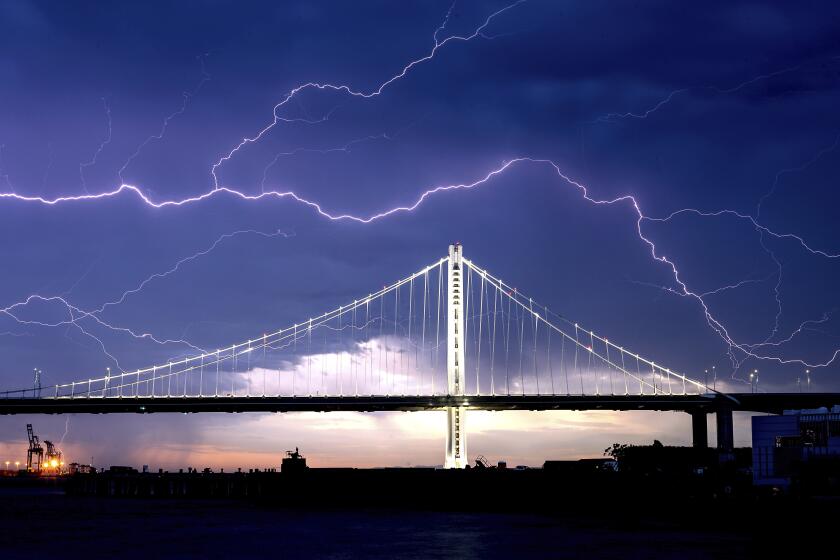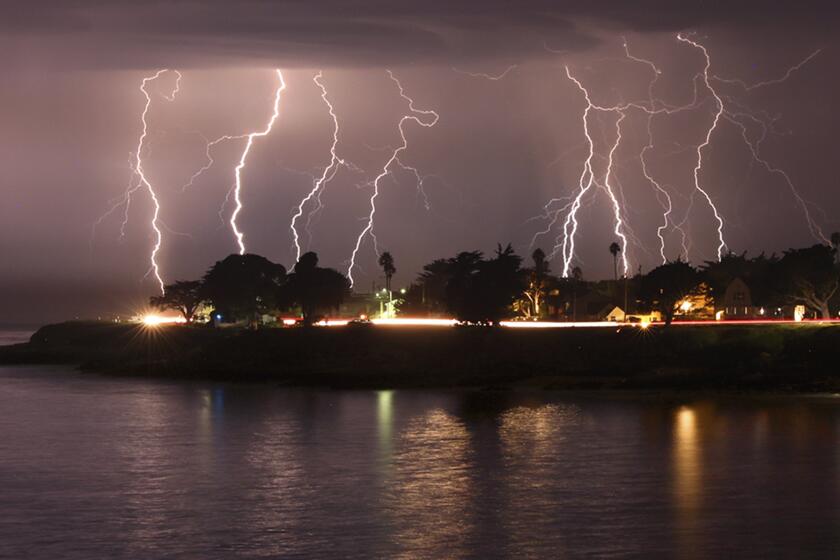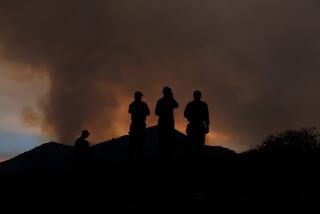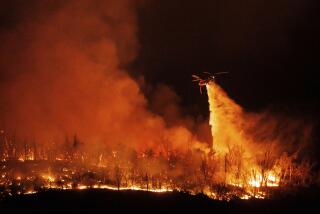Bay Area firestorms send thousands fleeing and cause dangerous air quality
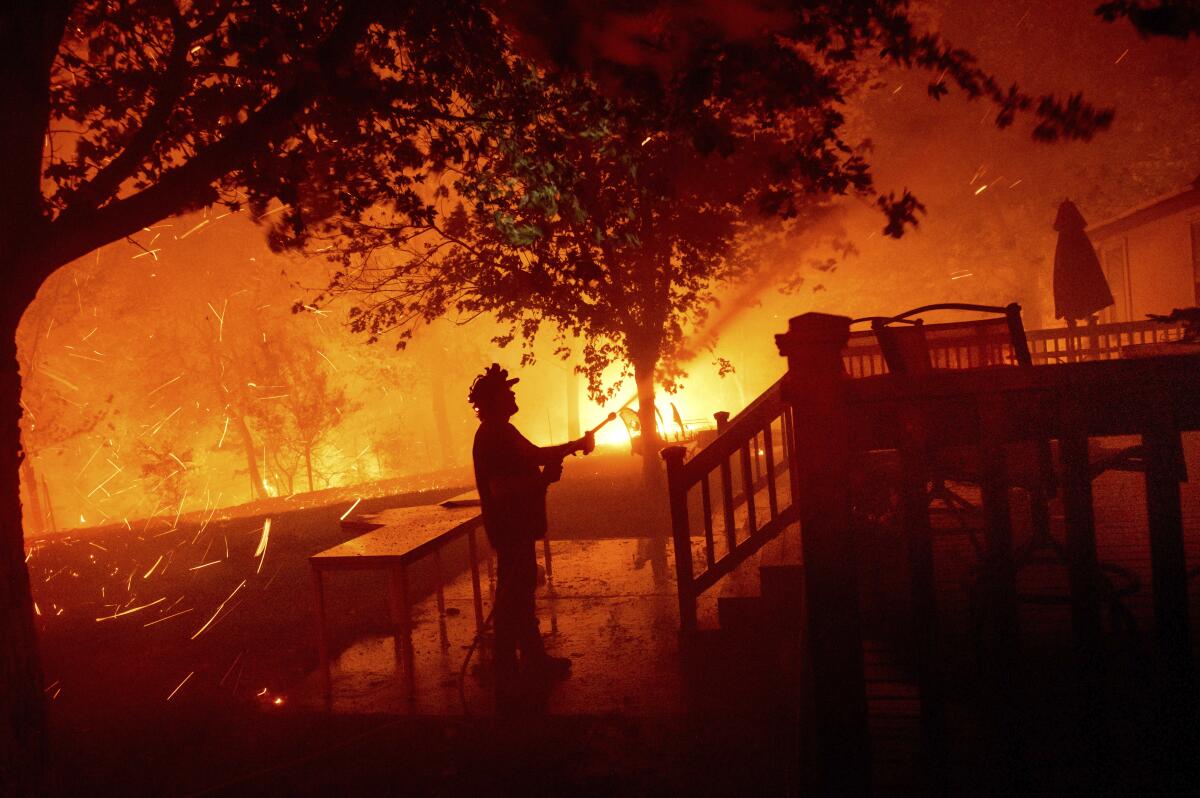
- Share via
VACAVILLE, Calif. — Already reeling from a pandemic and a record heat wave that has millions sweltering indoors, the San Francisco Bay Area is now besieged by fire, forcing tens of thousands to evacuate and leaving others inhaling air so smoky that experts warned of serious health risks.
Many residents say they’ve never seen such wildfire conditions, a product of high temperatures, strong winds and thousands of lightning strikes from unusual thunderstorms that started Sunday. As of Wednesday afternoon, the Bay Area was home to several of the 23 major fires statewide, a subset of the 367 blazes across California, according to Gov. Gavin Newsom.
“Those storms were not ordinary,” said Steve Cobb, a Dearborn Park resident and one of the thousands forced to flee their homes. “They were tropical … [with] constant flashes of light, crashing thunder and rain.”
As of late Wednesday, the most threatened area was Solano County, along the Interstate 80 corridor. After a fire roared close to Vacaville, a city of 100,000 northeast of San Francisco, it was beaten back but then blew up and jumped the freeway in the afternoon. Traffic was temporarily blocked in both directions as authorities worked to evacuate an area south of the interstate.
By Wednesday night, the fire and others in the area — collectively known as the LNU Lightning Complex — had burned more than 124,000 acres with zero containment. Vacaville Fire Chief Kris Concepcion warned residents online of a “long night ahead” with unstable and unpredictable weather conditions.
Another branch of that complex menaced Napa, Sonoma and Lake counties, forcing the evacuation of a hospital in the wine country town of St. Helena and remaining largely out of control as night fell.
Farther south, a grouping of 20 fires threatened the Silicon Valley area, while the rural areas north of Santa Cruz also saw a blaze that drove people down hilly mountain slopes toward the ocean, with fire close behind.
Such conflagrations would challenge emergency responders even in normal times, but these come as the coronavirus complicates the job of running evacuation centers and camps for firefighters.
Early Wednesday, Shawnee Whaley escaped her north Vacaville trailer park with her mother, Sharon Whitaker, 79. A phone call from a friend woke her minutes before they realized they had to go. When Whaley saw that the power was out, she said she flung open her front door “and saw the glow of the fire.”
They made it to an evacuation center, only to be turned away because it was full. They finally found shelter at the local cultural center, where they set up two cots away from others. Asked if they were concerned about the virus, they said: not so much.
“Getting burnt in a fire is way worse than getting COVID-19 at this point,” said Whaley, wrapped in a Red Cross blanket.
With so many blazes burning at the same time, state officials acknowledged Wednesday that they needed help and had asked for equipment and assistance from other states.
“We are experiencing fires the likes of which we haven’t seen in many, many years,” Newsom said at a news conference.
As one of the worst heat waves in years continues to broil California, millions are experiencing the havoc that ensues with the type of extreme weather that is growing more frequent with climate change.
Jeremy Rahn, a public information officer with the California Department of Forestry and Fire Protection, said the state had already requested 375 additional fire engines as well as hand crews from out-of-state agencies, and hired “nearly all available private firefighting ‘call-when-needed’ aircraft in the Western United States.”
“Firefighting resources are depleted as new fires continue to ignite,” he said during a media briefing Wednesday. Officials say nearly 7,000 personnel from state, local and federal agencies are assigned to the California fires.
Sunday’s lightning bolts were the Bay Area’s most widespread and violent in recent memory, and they struck on one of the hottest nights in years, said Daniel Swain, a climate scientist with UCLA and the National Center for Atmospheric Research.
They were the result of three separate weather phenomena: A high-pressure system that swirled hot desert air from Arizona and Nevada across the state; moisture floating in from Tropical Storm Elida off the coast of Mexico; and a thunderstorm in Sonora, Mexico, that sent a wave of uplifting pressure through the atmosphere, combining with the heat and moisture to create lightning strikes.
Destructive Bay Area fires have been fueled by an unusual combination of dry lightning and extreme heat.
The most threatened city Wednesday was Vacaville, in the path of part of the LNU Lightning Complex fire. That complex comprises at least three major incidents in Napa, Sonoma, Solano, Yolo and Lake counties. It jumped from 46,000 to more than 124,000 acres over the course of the day.
As of Wednesday night, 105 structures had been destroyed, 70 more had been damaged and 25,000 were threatened, fire officials said.
In the Santa Cruz Mountains, nearly two dozen fires — known as the CZU August Lightning Complex — have prompted the evacuation of at least 25,000 people, with at least 20 structures destroyed.
On Wednesday, a small but steady trickle of San Mateo County coast residents streamed into the evacuation center at the high school in Pescadero, a town south of Half Moon Bay.
Rita Mancera, the executive director of Puente, a local community organization, helped evacuees find hotel rooms and arrange accommodations for pets and livestock. She said roughly 70 families had visited the center since Tuesday evening, when evacuations were ordered.
Lance Storm, 39, said the lightning storms and fires were unlike anything he’d ever witnessed.
Storm lives on a communal farm in the Pescadero hills, and when the fire approached, he and six others decided to get out early — fearing a repeat of the people trapped in Paradise in 2018.
“I put everything I could into the bus,” he said, standing by his vehicle and holding a kitten named Energy. He said he set his two pigs, Delilah and Daisy, free — unable to get them into the bus.
By late Wednesday, authorities had closed the Pescadero shelter as fires threatened the community and others to the south in Santa Cruz County.
In many areas, a layer of ash covered the ground, kicked up by winds and adding to the pollution that clouded much of the Bay Area.
The American Lung Assn. warned that excessive heat, wildfire smoke and COVID-19 pose risks to those most vulnerable to respiratory problems.
“The combination of uncontained wildfires and extreme heat has created conditions that put even healthy individuals at risk,” said Dr. Afif El-Hasan, an association spokesman. “The ongoing COVID-19 pandemic only makes these potential effects more serious.”
Intense smoke and heat trigger coughing and wheezing, worsen lung function and can lead to bronchitis or even death, he said.
“The best thing you can do is to avoid outdoor air,” San Francisco Mayor London Breed said.
Several cities set up cooling centers to help people without air conditioning. In Redwood City, staff had equipped the Red Morton Community Center with air conditioning, bottles of water, free public Wi-Fi and plenty of space to maintain physical distance.
But Wednesday afternoon, the only two occupants were employees from the city’s facilities department.
“We think the site is just so new that nobody really knows about it,” said Rachael Grant, a city employee.
The fires have sent American Red Cross staff and county workers from across Northern California scrambling to prepare for a potential wave of evacuees, said Denise Everhart, the Red Cross’ Pacific Division disaster executive.
The Red Cross has set up 10 to 15 temporary evacuation points where residents’ needs are assessed before they’re sent to a hotel or motel, Everhart said. She said that the organization has put precautions in place against the coronavirus and that people should not hesitate to go to shelters.
“If you’re told to go, go. We’re all working together to keep people safe…. The fire is the risk.”
In Vacaville, 78-year-old Lloyd Broughton evacuated with his family after a firetruck came up his road at 3 a.m. He, his wife, Anne, 73, and daughter Kristine, 35, gathered their seven rescue cats and packed two cars.
All three suffer from breathing problems, and with a heavy layer of ash falling, they were already coughing and having trouble breathing, Kristine said.
“No one is ready for it,” Lloyd Broughton said of having to leave in the middle of a pandemic.
Times staff writers Luke Money, Colleen Shalby, Leila Miller and Maura Dolan contributed to this report.
More to Read
Sign up for Essential California
The most important California stories and recommendations in your inbox every morning.
You may occasionally receive promotional content from the Los Angeles Times.
